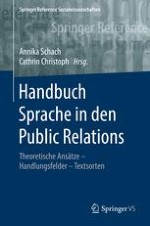2018 | OriginalPaper | Buchkapitel
Die Wirkung von Storytelling in der Wissenschafts-PR
verfasst von : Christian Ameseder, Silvia Ettl-Huber
Erschienen in: Handbuch Sprache in den Public Relations
Verlag: Springer Fachmedien Wiesbaden
Aktivieren Sie unsere intelligente Suche, um passende Fachinhalte oder Patente zu finden.
Wählen Sie Textabschnitte aus um mit Künstlicher Intelligenz passenden Patente zu finden. powered by
Markieren Sie Textabschnitte, um KI-gestützt weitere passende Inhalte zu finden. powered by
